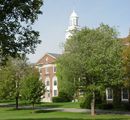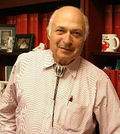Metals in living systems
Our symposium relates “metals”-a collection of positive ions enmeshed in a cloud of delocalized electrons to “living systems”-a concept defined as “open self organizing systems…alive and interacting with their environment…by means of information and material-energy exchanges” (Parent, 1996). Since “living systems” can either be a single cell or as organized as the mammalian brain-our talks will be focused on metals in the brain.This vast area includes the role of highly reactive alkali earth metals (sodium, potassium,calcium) necessary for neuronal and receptor signaling and transition metals(iron, copper, zinc) metals take much longer to part with electrons-but are critically important in both healthy and diseased brain This specific role of transition metals has been of particular interest to our laboratory and our speakers. All have been involved in determining the role of iron, copper,and zinc in normal and aging brain and how these relations alter cognitive and motor status. In order to determine these effects we have relied apon a number of different experimental techniques ranging from in vivo brain imaging and human subject studies (Susceptibility Weighted Magnetic Resonance Imaging) to direct regional analysis of autopsied human brain and experimental animals.
Dr.Kirsch will initiate the symposium by a review of the role of iron regulation in the mammalian brain, its compartmentalization, its forms, and the clinical effects of dysregulation
Matt Schrag will discuss the role of iron, copper, and zinc in the mammalian brain.Matt is a M.D./Ph.D. candidate whose publications have received worldwide attention
Dr.Claudius Mueller will continue with a discussion of the hemedegradation pathway in brain, the complementary roles of iron and copper
Grant McCauley will discuss the physico-chemical properties of iron, copper, and cobalt that in combination with other elements(sulfur for example) are essential for aerobic life
Dr.Kirsch will summarize the presentations and open the floor for questions directed to the panel.
Session organizer
Prof. Wolff M. Kirsch, MD is the Professor of Neurological Surgery and Professor of Biochemistry, the Director, Neurosurgery Center for Research, Training, and Education at Loma Linda University.
Confirmed speakers
- Dr.Claudius Muller, George Mason University: "The Cu/Fe relationship in living systems."
- Mr. Matt Schrag, Loma Linda University: "Mapping iron, zinc and copper in the Alzheimer's disease brain: a quantitative meta-analysis."
- Dr. Grant McAuley, Loma Linda University: "Quantification of Localized Brain Iron Sources Using Magnetic Resonance Phase Images."
- Prof. Wolff M. Kirsch, MD, Loma Linda University: "Iron-sulfur world theory and brain iron metabolism."
Program
Thursday, June 3, 8:30 AM - 12:20 PM
- Metals in Living Systems
- Timerman 131
Organizer/Presider: Wolff Kirsch
8:30 134 Iron-Sulfur World Theory and Brain Iron Metabolism. Wolff M. Kirsch, Matthew Zabel and Andrew Crofton, Loma Linda University
9:15 Discussion
9:20 135 Quantification of Localized Brain Iron Sources Using Magnetic Resonance Phase Images. Grant Mc Auley1, Matthew Schrag1, Pal Sipos2, Samuel Barnes5, Andre Obenaus3,4,6, E. Mark Haacke5,6,7, Barbara Holshouser6, Harry Vinters8,9 and Wolff Kirsch1, (1)Neurosurgery Center for Research, Training and Education, (2)University of Szeged, (3)Biophysics and Bioengineering, School of Science and Technology, (4)Non-Invasive Imaging Laboratory, (5)MRI Institute for Biomedical Research, (6)Loma Linda University Medical Center, Loma Linda, CA, (7)Radiobiology Program, Loma Linda University, (8)Wayne State University, Detroit, MI, (9)Department of Pathology and Laboratory Medicine, (10)David Geffen School of Medicine, University of California Los Angeles
10:05 Discussion
10:10 Intermission
10:25 136 Cu/Fe Relationship in Living Systems. Claudius Mueller1,2, Matthew Schrag1 and Wolff M. Kirsch1, (1)Loma Linda University, (2)George Mason University
11:10 Discussion
11:15 137 Mapping Iron, Zinc and Copper in the Alzheimer’s Disease Brain: A Quantitative Meta-Analysis. Matthew Schrag1, Claudius Mueller1,2, Mark A. Smith3 and Wolff M. Kirsch1, (1)Loma Linda University, (2)George Mason University, (3) Case Western Reserve University
12:00 Discussion
12:05 Panel Discussion

